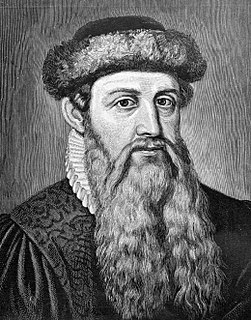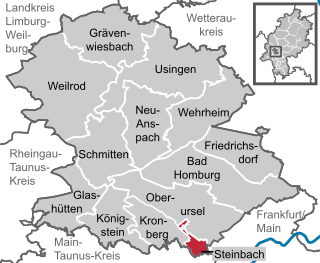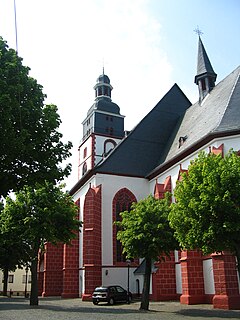
Cardinal Albert of Brandenburg was Elector and Archbishop of Mainz from 1514 to 1545, and Archbishop of Magdeburg from 1513 to 1545.

Johannes Gensfleisch zur Laden zum Gutenberg was a German blacksmith, goldsmith, inventor, printer, and publisher who introduced printing to Europe with the printing press. His introduction of mechanical movable type printing to Europe started the Printing Revolution and is regarded as a milestone of the second millennium, ushering in the modern period of human history. It played a key role in the development of the Renaissance, Reformation, the Age of Enlightenment, and the scientific revolution and laid the material basis for the modern knowledge-based economy and the spread of learning to the masses.

Wiesbaden is a city in central western Germany and the capital of the federal state of Hesse. As of January 2018, it had 289,544 inhabitants, plus approximately 19,000 United States citizens. The Wiesbaden urban area is home to approx. 560,000 people.

Eisenach is a town in Thuringia, Germany with 42,000 inhabitants, located 50 kilometres west of Erfurt, 70 km southeast of Kassel and 150 km northeast of Frankfurt. It is the main urban centre of western Thuringia and bordering northeastern Hessian regions, situated near the former Inner German border. A major attraction is Wartburg castle, which has been a UNESCO world heritage site since 1999.

Fritzlar is a small German town in the Schwalm-Eder district in northern Hesse, 160 km (99 mi) north of Frankfurt, with a storied history.

A Meistersinger was a member of a German guild for lyric poetry, composition and unaccompanied art song of the 14th, 15th and 16th centuries. The Meistersingers were drawn from middle class males for the most part.

Eltville am Rhein is a town in the Rheingau-Taunus-Kreis in the Regierungsbezirk of Darmstadt in Hesse, Germany. It lies on the German Timber-Frame Road.

St. Mary's Church in Lübeck was built between 1250 and 1350. It has always been a symbol of the power and prosperity of the old Hanseatic city, and is situated at the highest point of the island that forms the old town of Lübeck. It is part of the UNESCO World Heritage Site of the old Hanseatic City of Lübeck.

The Carolingian Saint Justin's Church in Frankfurt-Höchst is the oldest building in Frankfurt/Main and one of the oldest churches still existing in Germany. It is dedicated to Saint Justin the Confessor.

The Elector of Mainz was one of the seven Prince-electors of the Holy Roman Empire. As both the Archbishop of Mainz and the ruling prince of the territory, the Elector of Mainz held a powerful position during the Middle Ages. The Archbishop-Elector was president of the electoral college, arch-chancellor of the empire and primate of Germany until the dissolution of the empire in 1806.

Steinbach is a town in the Hochtaunuskreis that borders Frankfurt am Main to the east. Other neighbouring towns are Oberursel, Kronberg im Taunus and Eschborn. It is in the German state of Hesse.

The Catholic Cathedral of Limburg, also known as Georgsdom in German after its dedication to Saint George, is located above the old town of Limburg in Hesse, Germany. It is the cathedral of the Catholic Diocese of Limburg. Its high location on a rock above the river Lahn provides its visibility from far away. It is the result of an Early Gothic modernization of an originally Early Romanesque building and therefore shows a Romanesque-Gothic transitional style.

The Collegiate Church of St. Stephan, known in German as St. Stephan zu Mainz, is a Gothic hall collegiate church located in the German city of Mainz. It is known for windows created by Marc Chagall.

Frauenstein is the western-most borough of the city of Wiesbaden, located in the Rhine Main Area near Frankfurt and capital of the federal state of Hesse, Germany. The borough has a population of approximately 2,400. The formerly independent village was incorporated into Wiesbaden in 1928.

Weibersbrunn is a community with a population of close to 2,000 in the Aschaffenburg district in the Regierungsbezirk of Lower Franconia (Unterfranken) in Bavaria, Germany.

Großheubach is a market community in the Miltenberg district in the Regierungsbezirk of Lower Franconia (Unterfranken) in Bavaria, Germany.

Kirchberg, the Stadt auf dem Berg, called Kerbrich in Moselle Franconian, is a town in the Rhein-Hunsrück-Kreis (district) in Rhineland-Palatinate, Germany. It is the seat of the like-named Verbandsgemeinde, to which it also belongs.

The use of bronze dates from remote antiquity. This important metal is an alloy composed of copper and tin, in proportion which vary slightly, but may be normally considered as nine parts of copper to one of tin. Other ingredients which are occasionally found are more or less accidental. The result is a metal of a rich golden brown colour, capable of being worked by casting — a process little applicable to its component parts, but peculiarly successful with bronze, the density and hardness of the metal allowing it to take any impression of a mould, however delicate. It is thus possible to create ornamental work of various kinds.

Liebfrauenkirche is a Gothic-style Catholic parish church, located in the centre of Frankfurt, Germany. It was built in several phases from the 14th to the 16th century and serves today as a monastery church. Close to the shopping district, it serves as a place of rest even to visitors who are not religious. With an organ completed in 2008, it is a major venue for church music events.
























